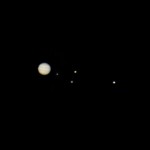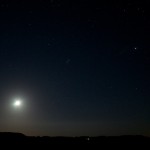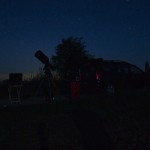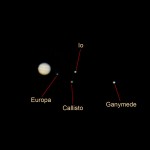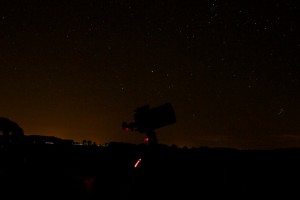 It is monday, and the weather report is optimistic that the sky should clear up around 8 pm. During the afternoon, I call Hippo to tell him I am planning to drive out to Utecht. He is currently on the road on business. Me, I have a customer appointment at my home later on and use the time until then to fill my car with gear.Just past 8 pm I call Hippo once more, but he is too tired to appreciate the clear skies. So I go alone. Having arrived among the fields, I notice that the harvest is still going on—there are a few harvesters driving around in some distance. Nobody but myself out here, so I pick the best spot for a 360° view and set up. I polar align and adjust a little, then Jupiter is my first target. It is just past 9 pm, and the planet is still rather low in the sky, with lots of turbulence in the air that close to the horizon. No matter, I set up my tripod for photography and take a picture of the whole thing. The wind is relatively low, but still strong enough to ruin my first attempts, so I move the tripod down the road a little, where it is protected by some bushes. Retrospectively, I should have set the ‘scope up there. Well, too late, not going to move the thing again now. Next time, I’ll know better. I set the camera almost straight up and expose for a minute at ISO 1600 to catch a bit of the Milky Way.
It is monday, and the weather report is optimistic that the sky should clear up around 8 pm. During the afternoon, I call Hippo to tell him I am planning to drive out to Utecht. He is currently on the road on business. Me, I have a customer appointment at my home later on and use the time until then to fill my car with gear.Just past 8 pm I call Hippo once more, but he is too tired to appreciate the clear skies. So I go alone. Having arrived among the fields, I notice that the harvest is still going on—there are a few harvesters driving around in some distance. Nobody but myself out here, so I pick the best spot for a 360° view and set up. I polar align and adjust a little, then Jupiter is my first target. It is just past 9 pm, and the planet is still rather low in the sky, with lots of turbulence in the air that close to the horizon. No matter, I set up my tripod for photography and take a picture of the whole thing. The wind is relatively low, but still strong enough to ruin my first attempts, so I move the tripod down the road a little, where it is protected by some bushes. Retrospectively, I should have set the ‘scope up there. Well, too late, not going to move the thing again now. Next time, I’ll know better. I set the camera almost straight up and expose for a minute at ISO 1600 to catch a bit of the Milky Way.
Both Jupiter and the night sky are beautiful; the Milky way is well visible. I set the telescope on M31 and spontaneously decide to take pictures. I home in on Vega, put on the Bahtinov mask, which I once more don’t really need because I already focused practically perfectly through the viewfinder of the camera.Back to M31. Now, the less-than-perfect set-up spot takes its toll; I don’t get a single picture that is not jiggled. I use the time the exposures take to enjoy the starscape, the rising of the moon and a few bottles of non-alcoholic beer.
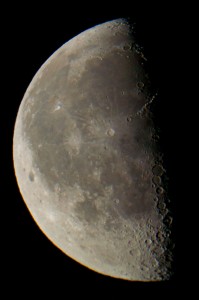 After 15 exposures at 30 seconds I decide that enough is enough and hope that I got enough good exposures to get a halfway good picture (unfortunately, I am wrong). I move on to M2. Here, too, the relatively soft wind is too much to get unjiggled pictures. In the meantime, the moon has risen high enough that taking pictures makes sense, so I shoot it. Once again, I enjoy the enormous light-collecting power of the C11—I have to go down to 1/320th of a second at ISO 400 to get detail. Since Jupiter has also risen higher and therefore above the worst of the atmospheric turbulence, the Fat One also gets shot. Looks like all four of the galilaean moons are on the same side. Later, at home, I make a composite picture (see below) that shows Jupiter with some atmospheric detail as well as the four big satellites.
After 15 exposures at 30 seconds I decide that enough is enough and hope that I got enough good exposures to get a halfway good picture (unfortunately, I am wrong). I move on to M2. Here, too, the relatively soft wind is too much to get unjiggled pictures. In the meantime, the moon has risen high enough that taking pictures makes sense, so I shoot it. Once again, I enjoy the enormous light-collecting power of the C11—I have to go down to 1/320th of a second at ISO 400 to get detail. Since Jupiter has also risen higher and therefore above the worst of the atmospheric turbulence, the Fat One also gets shot. Looks like all four of the galilaean moons are on the same side. Later, at home, I make a composite picture (see below) that shows Jupiter with some atmospheric detail as well as the four big satellites.
The night sky is simply too beautiful not to steal it; I take a wide-angle shot (see below) showing the moon, the Pleïades and Jupiter in a single frame. While those exposures get taken, I use my 8mm Planetary eyepiece to have a closer look at our biggest planet and notice both the Great Red Spot, and that the dark band that had gone missing during the last year seems to be back. After taking another picture of my gear in the moonlight, I pack up and drive home.
| A piece of the Milky Way | Jupiter & Co. | Moon, Pleïades, Jupiter |
| Equipment on-site | Jupiter & Co.—annotated |


